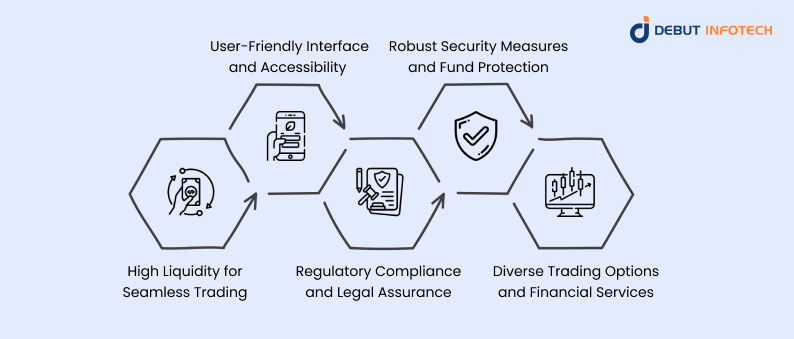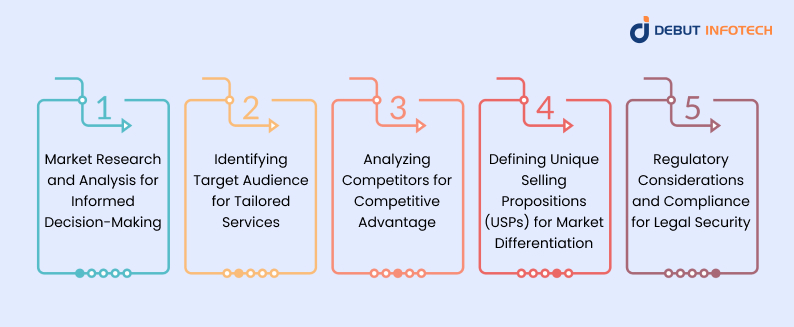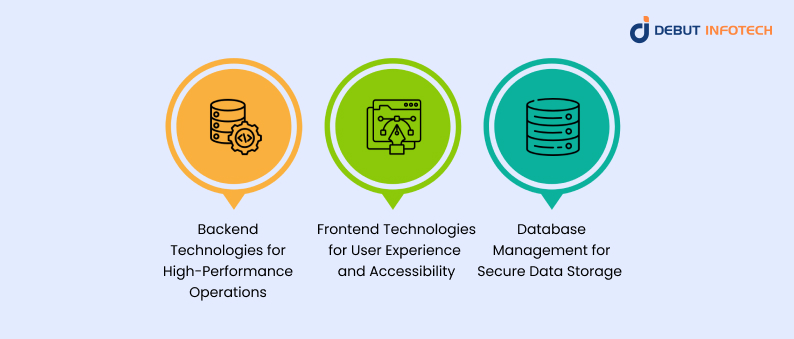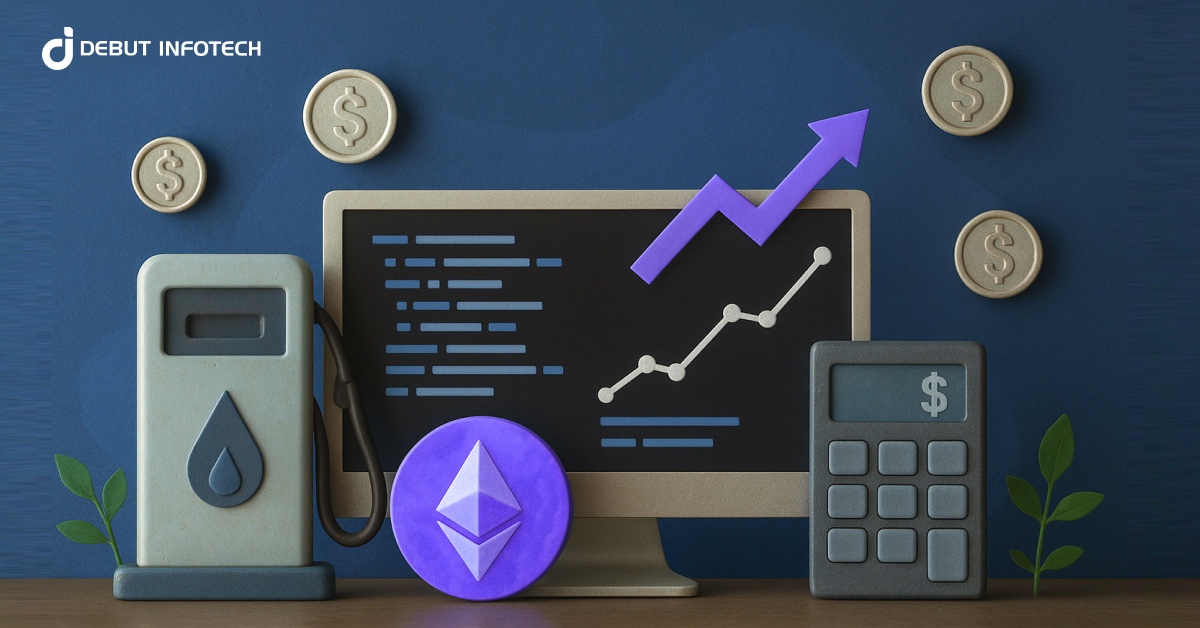
|
Getting your Trinity Audio player ready...
|
Centralized cryptocurrency exchanges (CEXs) serve as the primary gateway for trading digital assets. They offer structured and user-friendly platforms for buying, selling, and managing cryptocurrencies. Unlike decentralized exchanges, CEXs operate under a centralized authority, providing enhanced liquidity, faster transactions, and regulatory compliance.
Per a CoinGecko report, centralized crypto exchanges recorded a combined spot trading volume of $18.83 trillion in 2024. In addition, cryptocurrency exchanges recorded $43.5 billion in revenue in 2023, a 25% increase from the previous year.
In this article, we will discuss how CEXs function, their key components, and security mechanisms. Furthermore, we will shed light on the benefits of centralized crypto exchange for businesses and traders looking to participate in the crypto economy or develop their own exchanges.
Turn Your Crypto Exchange Idea into Reality!
Don’t just dream about running a top-tier crypto exchange—make it happen! We handle everything from architecture to compliance so you can focus on growing your business.
What is a Centralized Cryptocurrency Exchange (CEX)?
A centralized cryptocurrency exchange (CEX) is a digital marketplace that allows users to buy, sell, and trade cryptocurrencies through an intermediary platform. These exchanges are managed by a central entity that oversees transactions, liquidity, and security.
Compared to decentralized exchanges (DEXs), they provide an accessible user experience, rapid transaction speeds, and customer support, which encourages many new traders, as well as seasoned traders, to choose CEXs over DEXs.
How Do Centralized Crypto Exchanges Work?
Centralized exchanges function by acting as intermediaries between buyers and sellers. Users create accounts, deposit funds, and place orders, which are then matched through the platform’s trading engine. The exchange manages order execution, order books, and asset storage while ensuring liquidity.
Advanced security measures, compliance with regulations, and integration with payment gateways allow for seamless transactions.
As the cryptocurrency market expands, CEXs continue to innovate by incorporating features such as automated trading, staking, and fiat on-ramps, making digital asset trading more accessible and efficient.
History of Centralized Crypto Exchanges
Early Beginnings (2010–2013): The First Crypto Exchanges
The first centralized crypto exchange, BitcoinMarket, launched in 2010, allowing users to trade Bitcoin against fiat currency. Shortly after, Mt. Gox became the dominant exchange, managing over 70% of all Bitcoin transactions at its peak. However, security vulnerabilities led to its infamous 2014 hack, exposing the risks of centralized platforms.
Growth and Expansion (2014–2017): Rise of Leading Exchanges
Following Mt. Gox’s collapse, new exchanges like Binance, Coinbase, Bitfinex, and Kraken emerged, implementing stricter security measures and regulatory compliance. This period saw increased institutional interest, higher liquidity, and the introduction of fiat-to-crypto trading pairs, making digital assets more accessible to mainstream investors.
Regulatory Challenges and Innovation (2018–2020)
As crypto adoption surged, governments worldwide introduced stricter regulations, requiring exchanges to implement Know Your Customer (KYC) and Anti-Money Laundering (AML) policies. Despite regulatory hurdles, centralized exchanges continued innovating, introducing margin trading, futures contracts, and staking services to attract a broader audience.
Modern Era (2021–Present): Institutional Adoption and Market Dominance
Today, centralized exchanges remain the backbone of the crypto economy, with platforms like Binance, Coinbase, and Kraken handling billions in daily trading volume. They have expanded into NFT marketplaces, decentralized finance (DeFi) integrations, and regulatory partnerships, solidifying their role as key financial infrastructure in the evolving digital asset space.
Benefits of Centralized Crypto Exchanges

Centralized exchanges provide several advantages that contribute to their widespread adoption. Here are some of its benefits:
1. High Liquidity for Seamless Trading
Centralized exchanges maintain deep liquidity by pooling funds from a vast user base. This ensures that traders can buy and sell assets instantly at stable prices. High liquidity minimizes price slippage, allowing for smoother transactions, especially during market volatility. This makes CEXs ideal for both retail and institutional traders.
Many exchanges rely on crypto market making services to provide enhanced liquidity, ensuring tighter bid-ask spreads and a more efficient trading environment.
2. User-Friendly Interface and Accessibility
CEXs prioritize ease of use with intuitive interfaces, real-time market charts, and streamlined order execution. Even beginners can navigate trading with minimal effort. Features like mobile applications, fiat on-ramps, and customer support further enhance accessibility, ensuring users can trade anytime, anywhere, without technical barriers.
3. Regulatory Compliance and Legal Assurance
CEXs operate under strict regulatory frameworks, adhering to KYC (Know Your Customer) and AML (Anti-Money Laundering) policies. This compliance fosters trust, reduces fraud, and ensures that users trade in a legally protected environment.
For an OTC crypto exchange, regulatory adherence is equally crucial, as high-value trades require enhanced transparency and security.
Regulatory oversight also helps mitigate financial crimes, promoting a more transparent and secure trading ecosystem.
4. Robust Security Measures and Fund Protection
Leading exchanges implement stringent security protocols, including multi-signature wallets, cold storage, and encrypted databases. These measures safeguard users against cyber threats and unauthorized access. Additionally, many CEXs offer insurance protection, ensuring that user funds remain secure even in the event of a security breach or operational failure.
5. Diverse Trading Options and Financial Services
Beyond standard crypto trading, CEXs offer futures, margin trading, staking, and lending services. These financial tools provide users with opportunities to maximize profits and diversify their portfolios. The availability of various trading pairs and fiat integration enhances the overall trading experience, making CEXs a comprehensive investment platform.
Key Features of Centralized Crypto Exchanges
Here are some key features of centralized exchanges:
1. Trading Engine for Efficient Order Execution
The trading engine is the backbone of a CEX and is responsible for matching buy and sell orders in real time. It processes transactions with minimal latency, ensuring fair pricing and smooth trade execution.
The best crypto trading platforms also utilize advanced algorithms to optimize speed and accuracy, supporting high-frequency trading and reducing market inefficiencies.
2. User Management System for Secure Account Access
A robust user management system includes registration, identity verification, and authentication processes. Features like two-factor authentication (2FA), biometric login, and account recovery enhance security. These measures prevent unauthorized access, ensuring user accounts remain protected while enabling smooth onboarding and compliance with regulatory requirements.
3. Wallet Integration for Secure Asset Storage
CEXs provide integrated wallets for storing cryptocurrencies securely. Many hybrid crypto exchanges use a combination of hot and cold storage solutions to balance accessibility and security. Cold wallets keep most funds offline, protecting them from cyber threats. In contrast, hot wallets allow for quick deposits and withdrawals, facilitating seamless trading.
4. Payment Gateway Support for Fiat and Crypto Transactions
Centralized exchanges support multiple payment methods, including bank transfers, credit/debit cards, and third-party payment services. This enables users to deposit and withdraw funds conveniently. Fiat integration expands accessibility, allowing users to buy and sell cryptocurrencies with traditional currencies, bridging the gap between conventional finance and digital assets.
5. Regulatory Compliance for Legal and Financial Security
CEXs adhere to financial regulations, ensuring secure and legally compliant operations. Compliance measures include Know Your Customer (KYC), Anti-Money Laundering (AML) protocols, and transaction monitoring. These policies enhance transparency, prevent illicit activities, and build user trust, making centralized exchanges a reliable platform for cryptocurrency trading and investment.
Understanding Centralized Crypto Exchange Development
Developing a centralized exchange requires a structured approach that includes strategic planning, technical development, and regulatory compliance. From conducting market research to implementing security measures, each phase is crucial in ensuring a reliable trading platform.
With the growing demand for cryptocurrency exchanges, businesses are focusing on innovation, scalability, and security to enhance user trust and operational efficiency.
Planning and Strategy for Centralized Crypto Exchange Development

1. Market Research and Analysis for Informed Decision-Making
Thorough market research helps identify industry trends, user demands, and potential challenges. Analyzing market dynamics, trading volumes, and emerging technologies ensures a competitive edge. Understanding regulatory landscapes and investor behavior further refines development strategies, enabling the creation of a well-structured, scalable, and future-proof crypto exchange.
2. Identifying Target Audience for Tailored Services
Defining the target audience—whether retail traders, institutional investors, or crypto enthusiasts—helps shape the exchange’s features and services. Analyzing user preferences, trading habits, and geographical distribution ensures a user-friendly platform. Offering region-specific payment options, language support, and compliance measures enhances accessibility and attracts a loyal customer base.
3. Analyzing Competitors for Competitive Advantage
Assessing competitor exchanges helps identify market gaps, strengths, and weaknesses. Reviewing their fee structures, trading pairs, security features, and customer feedback provide insights for differentiation. This is especially important in P2P crypto exchange development, where understanding competitor strategies can help refine features like escrow services, dispute resolution, and decentralized trading mechanisms.
By learning from competitors’ successes and failures, developers can enhance their platform’s efficiency, user experience, and security, positioning it as a preferred choice in the market.
4. Defining Unique Selling Propositions (USPs) for Market Differentiation
Establishing strong USPs ensures the exchange stands out in a crowded market. Whether through lower fees, enhanced security, advanced trading tools, or unique liquidity solutions, a well-defined value proposition attracts users. Prioritizing innovation, seamless user experience, and compliance builds trust and increases adoption among traders and investors.
5. Regulatory Considerations and Compliance for Legal Security
Navigating legal frameworks ensures the Bitcoin exchange operates within regulatory guidelines. Compliance with KYC (Know Your Customer), AML (Anti-Money Laundering), and regional financial laws prevents legal issues and enhances credibility.
In decentralized exchange development, regulatory considerations can be more complex, as these platforms operate without central oversight. Partnering with legal experts and securing necessary licenses fosters trust, reduces risks, and ensures smooth business operations.
Technical Development of a Centralized Cryptocurrency Exchange

1. Backend Technologies for High-Performance Operations
The backend of a centralized cryptocurrency exchange handles critical functions such as order matching, transaction processing, and security enforcement. It is built using scalable programming languages like Python, Java, or C++. A well-optimized backend ensures minimal latency, seamless trade execution, and real-time data synchronization. Additionally, integrating robust APIs allows for third-party services, market data aggregation, and automated trading functionalities.
2. Frontend Technologies for User Experience and Accessibility
The frontend of a CEX must be intuitive, responsive, and optimized for different devices. Technologies like React, Angular, or Vue.js help create a dynamic user interface with real-time trading charts, order book visibility, and portfolio tracking. A well-designed frontend enhances user engagement, ensuring seamless navigation, quick order execution, and accessibility across web and mobile platforms.
Investing in a high-quality frontend can influence the overall crypto exchange development cost, as advanced UI/UX features and real-time data processing require robust infrastructure and development expertise.
3. Database Management for Secure Data Storage
A CEX requires a high-performance database to store and manage large volumes of trading data, user information, and transaction records. This is especially critical for a crypto derivatives exchange, where complex financial instruments and leveraged trades generate extensive data that must be processed in real-time.
Databases like PostgreSQL, MongoDB, or MySQL ensure structured data organization and efficient retrieval. Implementing encryption, redundancy, and disaster recovery mechanisms protects sensitive data from breaches, ensures regulatory compliance, and guarantees uninterrupted operations even in case of system failures.
Common Security Threats in CEXs
Here are common threats affecting the security of centralized exchanges:
1. Hacking: A Prime Target for Cybercriminals
Since centralized exchanges store large amounts of user funds, they are attractive targets for hackers. Cybercriminals exploit vulnerabilities in trading engines, APIs, or wallets to gain unauthorized access. High-profile breaches have led to significant losses, making it essential for exchanges to implement multi-layered security defenses and continuous threat monitoring.
2. Phishing: Manipulating Users for Credential Theft
Phishing attacks deceive users into revealing login credentials through fake emails, websites, or messages mimicking legitimate exchanges. Attackers often use urgency or incentives to trick users into clicking malicious links. Even some of the top decentralized exchanges face phishing threats, making it crucial to strengthen user awareness, implement anti-phishing codes, and enforce domain verification. These measures can significantly reduce the risk of credential theft and unauthorized access.
Security Measures in Centralized Exchange Development
Here are some advanced security measures implemented in centralized crypto exchange development to protect users:
1. Encryption for Data Protection
Strong encryption methods such as AES-256 and SSL/TLS protocols ensure that sensitive user data remains protected during transmission and storage. Encrypted communication channels prevent unauthorized interception, reducing the risks of data breaches. A reliable cryptocurrency exchange development company will provide proper encryption that safeguards API interactions and login credentials. This will ensure that cybercriminals cannot exploit vulnerabilities to access confidential information or manipulate trading activities.
2. Multi-Signature Wallets for Enhanced Fund Security
Multi-signature (multi-sig) wallets require multiple private keys to authorize transactions, reducing the risk of unauthorized fund withdrawals. By distributing keys across different parties, this mechanism ensures no single entity can compromise assets. Multi-sig wallets are particularly useful for high-value transactions and corporate accounts, enhancing security while maintaining user control over their crypto holdings.
3. Regular Security Audits for Vulnerability Detection
Periodic security audits, conducted by professional cybersecurity firms, help identify and mitigate potential threats. These audits assess code vulnerabilities, network security, and access controls. Automated penetration testing and manual assessments ensure the platform remains resilient against cyberattacks. Implementing continuous monitoring further strengthens security, allowing for real-time threat detection and swift incident response.
4. Two-Factor Authentication (2FA) for User Account Protection
2FA adds an extra security layer by requiring users to verify their identity through an additional method, such as a time-sensitive code sent to their mobile device. This prevents unauthorized access, even if login credentials are compromised. A white label crypto exchange can further enhance security by supporting biometric authentication and hardware security keys for stronger identity verification.
5. Withdrawal Whitelists for Restricted Fund Transfers
Withdrawal whitelists enable users to pre-approve specific addresses for fund withdrawals, preventing unauthorized transactions. Even if an account is compromised, assets can only be sent to trusted addresses. This feature minimizes risks from phishing attacks and insider threats, providing users with additional control over their funds and enhancing overall security.
Your Crypto Exchange, Your Rules—We’ll Build It!
Want a robust, secure, and user-friendly crypto exchange? We develop custom solutions tailored to your vision. Let’s create a trading platform that stands out.
Conclusion
Centralized cryptocurrency exchanges are a vital part of the digital asset ecosystem. They provide secure and efficient trading experiences for users. Thanks to their liquidity, regulatory compliance, and advanced trading features, they are preferred among retail and institutional investors alike.
CEXs will need to strike a balance between regulatory compliance, user security, and innovative offerings as they adapt to changing markets and user expectations. Even if you’re a trader or an entrepreneur looking to develop a CEX, it’s crucial to understand the core aspects of exchange development, security protocols, and compliance requirements to ensure long-term success in the crypto market.
FAQs
Building a centralized crypto exchange means handling security, liquidity, and compliance. You’ll need a solid trading engine, a secure wallet system, and a user-friendly interface. Partner with a reliable liquidity provider, follow regulations and ensure top-tier security. Hiring experienced developers helps streamline the process.
Most exchanges make money through trading fees, withdrawal fees, and listing fees for new tokens. Some also offer premium services, margin trading, or staking options. Holding user funds allows them to earn interest, and partnerships with market makers help boost liquidity and revenue.
Security threats, regulatory compliance, and liquidity management are major hurdles. High-performance infrastructure is essential to handle trade volumes. Regular updates, customer support, and maintaining user trust are ongoing challenges. Market competition is tough, so standing out with unique features is crucial.
Look for strong security measures, regulatory compliance, and positive user reviews. A good exchange has high liquidity, responsive customer support, and transparent fees. Two-factor authentication (2FA) and cold wallet storage are must-haves. Research past security breaches and how the platform handled them.
You’ll need a trading engine to match orders, a secure wallet system for asset storage, an admin panel for monitoring, and a user-friendly interface. KYC/AML compliance, liquidity management, and robust security features like encryption and 2FA are also essential for smooth operations.


